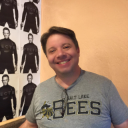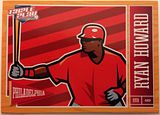
- Wayne Garrett was an infielder for three teams from 1969-1978. He then played in Japan for two seasons. His brother Adrian also played in the majors in the 70s.
- Garrett was drafted by the Milwaukee Braves in 1965. He played in the Braves' system from 1965-1968 and then was taken by the New York Mets in the Rule 5 draft. Wayne was still only 21 years old. He stuck with the Mets and platooned with Ed Charles at 3B for the 1969 World Champions. He batted .218 in 400 at bats, but he batted .385 in the National League Championship Series and homered once in the World Series.
- Wayne was a utility guy in 1970 and he improved his average to .254 in 366 at bats. Garrett spent part of the 1971 season in military service and he played 11 games for AAA Tidewater. He came back to the Mets in late July and batted .213 in 56 games. In 1972 he batted .232 in 111 games.
- Garrett was given the starting 3B job in 1973 and he had his best season. He hit 16 home runs and batted .256 in 140 games. He didn't do much in the playoffs -- he batted .087 in the NLCS and .167 in the World Series (although two of his WS hits were home runs). Wayne made the last out in game 7 of the World Series, popping out to Bert Campaneris. He tied a World Series record by striking out 11 times in a seven-game series.
- Wayne started at 3B again in 1974. He hit 13 home runs, but his average dropped to .224 in 151 games. Garrett went 0-10 in a 25-inning game on September 11, 1974. He returned to a utility role in 1975, batting .266 in 274 at bats.
- Garrett started the 1976 season with the Mets. On July 21 he was traded with Del Unser to the Montreal Expos for Jim Dwyer and Pepe Mangual. For the two teams he played in 139 games and batted .231. He walked 82 times for an on base percentage of .356. Wayne always had pretty good on-base percentages even if his batting averages were low.
- In 1977 Garrett had his highest batting average (.270) but he played in only 68 games and batted only 159 times. Wayne's last season in the majors was 1978. He started with the Expos and was purchased by the St. Louis Cardinals on July 21. All together Garrett played in 82 games and batted .250. After the season Wayne signed with the Chunichi Dragons of the Japanese League and spent two seasons there.
Liked to face: Bob Gibson (.333, 2 HR in 66 AB); Jim Lonborg (.362 in 47 AB), Rick Reuschel (.360, 2 HR in 50 AB).
- Hated to face: Burt Hooton (.193 in 57 AB); Rick Wise (.143 in 35 AB); Ron Reed (.100 in 30 AB)
- Now Wayne is a salesman for his older brother Jimmy's irrigation company. Here is an article about Wayne's memories of the 1969 season.






















































































































































